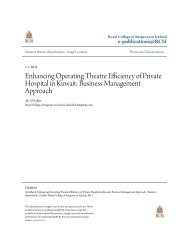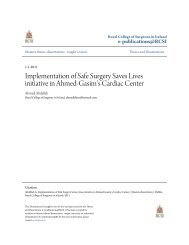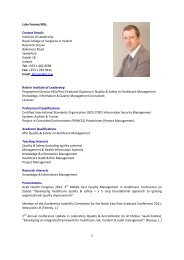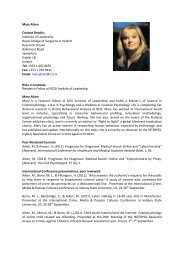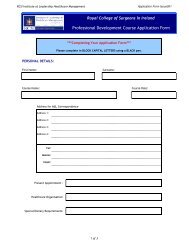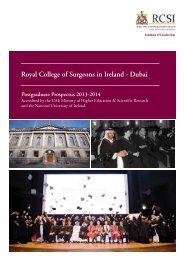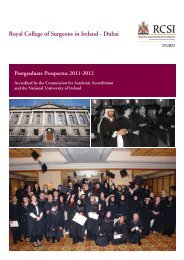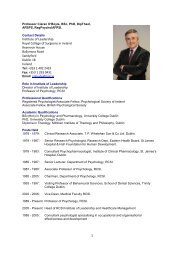Improving the Assessment and Triage of Patients with Mental Illness ...
Improving the Assessment and Triage of Patients with Mental Illness ...
Improving the Assessment and Triage of Patients with Mental Illness ...
Create successful ePaper yourself
Turn your PDF publications into a flip-book with our unique Google optimized e-Paper software.
questioning <strong>the</strong> patient about <strong>the</strong>ir presentation could result in unpredictable responses <strong>and</strong><br />
violent outbursts.<br />
Following on from <strong>the</strong>se discussions I reviewed <strong>the</strong> nursing documentation which<br />
outlines nursing care <strong>and</strong> interventions undertaken by <strong>the</strong> nursing staff. I found a considerable<br />
deficit in recording <strong>of</strong> information for <strong>the</strong> patient presenting <strong>with</strong> mental illness. The nursing<br />
documentation only appeared to be commenced if a decision was made to admit <strong>the</strong> patient.<br />
This documentation contained very little information on <strong>the</strong> patient including <strong>the</strong>ir<br />
psychological state, who <strong>the</strong>y were accompanied by or if <strong>the</strong>y required supervision whilst in<br />
<strong>the</strong> ED. When staff were questioned about <strong>the</strong> poor st<strong>and</strong>ard <strong>of</strong> documentation it was<br />
explained as being due to <strong>the</strong> pressures associated <strong>with</strong> a busy ED. In addition to this some<br />
staff suggested that as <strong>the</strong> patient displayed no physical illness <strong>the</strong>y didn’t require regular<br />
observation. However <strong>the</strong> importance <strong>of</strong> proper nursing documentation cannot be<br />
overemphasised. The purpose <strong>of</strong> such record keeping is to provide precise <strong>and</strong> timely<br />
accounts <strong>of</strong> patient care <strong>and</strong> to demonstrate <strong>the</strong> nurses’ knowledge <strong>and</strong> skills according to<br />
nursing’s pr<strong>of</strong>essional code <strong>of</strong> practice (DeWolf-Bosek <strong>and</strong> Ring, 2010). From a legal<br />
perspective <strong>the</strong> ED nursing documentation is <strong>of</strong>ten requested for submission in relation to law<br />
suits or coroner’s inquests. This fur<strong>the</strong>r displays a need for accurate <strong>and</strong> relevant record<br />
keeping in line <strong>with</strong> <strong>the</strong> nurses’ code <strong>of</strong> conduct (An Bord Altranais, 2000).<br />
In light <strong>of</strong> <strong>the</strong> information ga<strong>the</strong>red from <strong>the</strong>se informal discussions <strong>with</strong> staff I<br />
commissioned a questionnaire (Appendix I) to ga<strong>the</strong>r information on a number <strong>of</strong> issues<br />
including: (a) <strong>the</strong> number <strong>of</strong> staff <strong>with</strong> a formal education in mental health, (b) <strong>the</strong>ir personal<br />
level <strong>of</strong> confidence in <strong>the</strong> ability to treat <strong>and</strong> assess patients presenting <strong>with</strong> mental illness<br />
The format <strong>of</strong> <strong>the</strong> questionnaire was tailored to suit <strong>the</strong> respondents work schedule as I was<br />
cognisant <strong>of</strong> time constraints. I was aware that many o<strong>the</strong>r studies were taking place <strong>with</strong>in<br />
<strong>the</strong> ED <strong>and</strong> I did not wish to over burden staff <strong>with</strong> a lengthy survey. I sent <strong>the</strong> questionnaire<br />
to 65 staff, including frontline clinical nurse managers, clinical facilitators <strong>and</strong> staff nurses. A<br />
poster was circulated around <strong>the</strong> department a week prior to <strong>the</strong> distribution <strong>of</strong> <strong>the</strong><br />
questionnaire. The poster gave a synopsis <strong>of</strong> <strong>the</strong> reasons for <strong>the</strong> questionnaire <strong>and</strong> requested<br />
staff participation.<br />
As a result <strong>of</strong> <strong>the</strong> questionnaire <strong>and</strong> discussions held <strong>with</strong> staff it was evident that<br />
<strong>the</strong>re was a sense <strong>of</strong> urgency to change <strong>the</strong> way things were done. Kotter (1996) describes<br />
19




